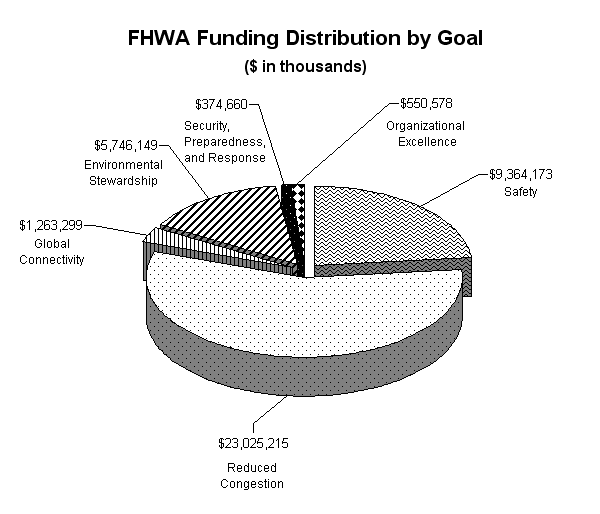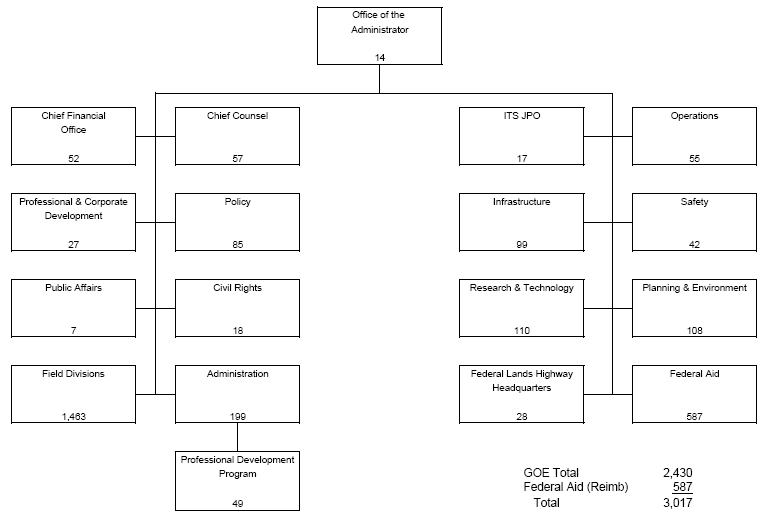FEDERAL HIGHWAY ADMINISTRATION
FISCAL YEAR 2008 PERFORMANCE BUDGET
ADMINISTRATOR’S OVERVIEW
The 50th anniversary of the Interstate highway system, commemorated throughout 2006, provided an opportunity to look back and celebrate one of the most significant transportation developments in history, and also gives us a chance to look forward to the future of our transportation system. The Dwight D. Eisenhower System of Interstate and Defense Highways is essential to America’s prosperity and way of life, providing a vital link for connecting goods to markets here and around the world, and bringing together people from our Nation’s cities, towns, and rural communities. The Interstate system has helped make the United States the most mobile country in the world.
Americans’ ever-growing demand for mobility, however, has outpaced highway system capacity. On the 50th anniversary of the Interstate system, increasing congestion on the Nation’s highway networks threatens the very economic prosperity and quality of life that the system has served to improve since its inception. To help reverse this trend and reduce congestion, the Department of Transportation launched a new, national initiative to reduce congestion in America. This plan, the National Strategy to Reduce Congestion on America’s Transportation Network, provides a blueprint for Federal, State, and local officials to follow and work together to tackle this problem. Along with the Department, the Federal Highway Administration (FHWA) will build upon the programs and authorities provided by the Safe, Accountable, Flexible, Efficient Transportation Equity Act: A Legacy for Users (SAFETEA-LU) and focus those resources, funding, staff and technology to help our State and local partners reduce congestion.
SAFETEA-LU includes a number of programs to encourage and promote the safe and efficient management and operation of integrated, intermodal surface transportation systems to mitigate the impacts of traffic congestion and improve system reliability, including the real-time system management information program, high occupancy vehicle facilities, the value pricing program, and surface transportation congestion relief solutions research. FHWA’s Fiscal Year (FY) 2008 budget reflects the authorized funding levels for these programs, and also proposes an additional $175 million for Congestion Initiative activities to be funded through reprogramming unobligated balances of inactive highway demonstration and other projects.
The FY 2008 budget request for the FHWA supports the Department’s new initiative to reduce congestion in concert with the Agency’s top priorities to make transportation safer and more secure, and to preserve the environment. The resources reflected in the budget will support highway programs that improve transportation for a strong America into the future – for the next 50 years and beyond.
Summary of FY 2008 Budget Request
The FHWA’s FY 2008 budget includes total budgetary resources of $40.3 billion. This level reflects a Federal-aid highway obligation limitation of $39.6 billion and $739 million in exempt contract authority, consistent with the base level authorized for FY 2008 in SAFETEA-LU, and includes $429.8 million for research programs and a Limitation on Administrative Expenses of $384.6 million. In addition, the budget proposes $175 million specifically for Congestion Initiative activities, to be funded by reprogramming unobligated balances of Federal-aid highway program inactive demonstration and other projects.
The request supports the Department’s goals and policy initiatives, and the Agency’s priorities of improving highway safety, minimizing project delays, reducing traffic congestion, and promoting environmental stewardship and streamlining. In FY 2008, the FHWA will continue to implement highway programs authorized in SAFETEA-LU, undertake efforts to improve financial stewardship and oversight, and carry out the President’s Management Agenda.
Performance Budget
The FHWA’s FY 2008 budget submission is presented as a performance-based budget that is aligned with the Department of Transportation’s Strategic Plan, 2006-2011. Sections 2 and 3 of the submission display budget information by appropriations account, and Section 4 displays budget information by performance category and program activities. The integrated performance plan and budget reflects how resources impact the FHWA’s outcome goals and provides benefits for the people and goods traveling on the Nation’s highways.
The chart below illustrates the allocation of FY 2008 FHWA funds by strategic goal.

Federal-aid Highway Program
The FY 2008 budget request totals $40.3 billion for the Federal-aid Highway Program (FAHP). This funding reflects the level authorized in SAFETEA-LU and includes an obligation limitation of $39.6 billion for FAH programs and $739 million in exempt contract authority ($639 million for Equity Bonus and $100 million for Emergency Relief). The budget does not request an increase in the FY 2008 obligation limitation to reflect the revenue aligned budget authority (RABA) calculation. The FY 2008 obligation limitation is consistent with the base funding level authorized in SAFETEA-LU. However, in the interest of preserving a positive cash balance in the Highway Account of the Highway Trust Fund, additional obligation limitation is not requested. Within the overall Federal-aid obligation limitation, the FY 2008 request also includes an obligation limitation of $429.8 million for research programs and a Limitation on Administrative Expenses of $384.6 million.
Funding levels requested for the FAHP provide investments in highway improvements that support the achievement of the Department’s strategic objectives.
Safety – The budget includes $9.4 billion for activities contributing to the goal to reduce transportation-related deaths and injuries. SAFETEA-LU significantly increased funding for safety programs beginning in 2006 and established several new safety programs, including the Highway Safety Improvement Program (HSIP), which is funded at approximately $1 billion annually. These increased resources will strengthen the ability of FHWA to provide the technical assistance, training, and delivery of national safety programs requested by the States to impact the overall fatality rate, thereby improving Agency operations and saving lives.
Reduced Congestion – The budget includes $23.0 billion for activities contributing to the goals to reduce congestion and improve infrastructure in all modes. Highway funds apportioned to the States in FY 2008 will be used to increase roadway throughput by adding system capacity, and also for improvements to infrastructure on the Interstate System, rural and urban roads that are part of the NHS, bridges, and to continue the Highways for LIFE program. Research and Intelligent Transportation Systems funding will include programs to improve mobility through the development and testing of tools for integrated corridor operations and other applications.
The budget proposes an additional $175 million for Congestion Initiative activities, as follows:
$100 million for the Value Pricing Pilot Program. Funding for the Value Pricing Pilot Program will accelerate progress in advancing the Urban Partnership Agreement track of the Congestion Initiative, which aims to implement pricing programs in selected metropolitan areas. The $100 million is in addition to the $12 million authorized in SAFETEA-LU for the Value Pricing Pilot Program in FY 2008, bringing the total program to $112 million.
$25 million to support the Corridors of the Future program. These funds will be utilized on a discretionary basis by the Secretary to facilitate development of selected Corridors of the Future projects.
$25 million for the Real-time System Management Information Program. Funding to support the Real-time System Management Information Program (section 1201 of SAFETEA-LU) will be provided to State and local transportation agencies to plan or implement monitoring services collecting information relative to the program.
$25 million for the ITS R&D program to expand congestion-related research activities. These funds will support one or more new major ITS initiatives focused on reducing congestion.
In addition, funding within the Limitation on Administrative Expenses will be utilized to support Congestion Initiative activities, including increased staff support, travel to congested metropolitan areas, increased technical assistance to State and local partners, and extensive outreach.
Global Connectivity – The budget includes $1.3 billion for activities contributing to the goal of more efficient movement of cargo throughout the supply chain. In FY 2008, FHWA will continue to collaborate with State and local government agencies and the private sector to ensure more effective planning, improved data collection, modeling and analysis, and infrastructure and operational improvements. Research and ITS funds will be used to promote and facilitate a more efficient global transportation system that enables economic growth and development.
Environmental Stewardship – The budget includes $5.7 billion for activities contributing to the goals to reduce pollution and other adverse environmental effects of transportation and transportation facilities and to streamline environmental review of transportation infrastructure projects. In FY 2008, $1.6 billion is requested for the Congestion Mitigation and Air Quality (CMAQ) Improvement program to help States make improvements in air quality. In addition, NHS, STP, Research, and ITS funds will be used to support projects that reduce the social and environmental impact of system infrastructure improvements.
Security – The budget includes $374.7 million for activities contributing to the goal of rapid recovery of transportation in all modes from intentional harm and natural disasters. FAHP funds will be used to support the projects and initiatives identified in State and local security plans, such as increased bridge surveillance, retrofit of existing facilities, or the enhancement of new facilities to meet current and future security needs.
Organizational Excellence – The budget reflects $550.6 million attributed to activities contributing to the goal to achieve strategic management of human capital, competitive sourcing goals, financial performance goals, budget and performance integration goals, and e-government goals. A Limitation on Administrative Expenses (LAE) of $384.6 million is requested for FY 2008 for the necessary salaries and benefits of 2,430 full-time equivalents (FTE) and on-going administrative expenses in support of the above Federal programs.
EXHIBIT-I
FEDERAL HIGHWAY ADMINISTRATION ORGANIZATION CHART with AUTHORIZED FTP POSITIONS FY 2008
